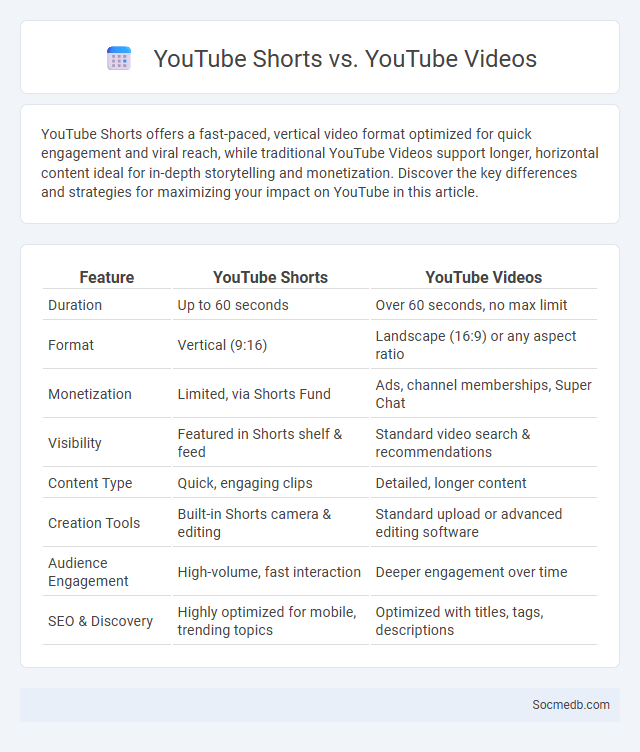
Photo illustration: YouTube Shorts vs YouTube Videos
YouTube Shorts offers a fast-paced, vertical video format optimized for quick engagement and viral reach, while traditional YouTube Videos support longer, horizontal content ideal for in-depth storytelling and monetization. Discover the key differences and strategies for maximizing your impact on YouTube in this article.
Table of Comparison
| Feature | YouTube Shorts | YouTube Videos |
|---|---|---|
| Duration | Up to 60 seconds | Over 60 seconds, no max limit |
| Format | Vertical (9:16) | Landscape (16:9) or any aspect ratio |
| Monetization | Limited, via Shorts Fund | Ads, channel memberships, Super Chat |
| Visibility | Featured in Shorts shelf & feed | Standard video search & recommendations |
| Content Type | Quick, engaging clips | Detailed, longer content |
| Creation Tools | Built-in Shorts camera & editing | Standard upload or advanced editing software |
| Audience Engagement | High-volume, fast interaction | Deeper engagement over time |
| SEO & Discovery | Highly optimized for mobile, trending topics | Optimized with titles, tags, descriptions |
Introduction: Understanding YouTube Content Formats
YouTube content formats include vlogs, tutorials, reviews, and live streams, each designed to engage different audiences effectively. Your choice of format should align with your target demographic and content goals to maximize reach and impact. Mastering these formats enables you to create compelling videos that increase viewer retention and channel growth.
What Are YouTube Shorts?
YouTube Shorts are vertical, short-form videos up to 60 seconds designed for quick and engaging content consumption on mobile devices. Your Shorts appear in a dedicated section on YouTube, making it easier for creators to reach a wider audience through a format optimized for rapid viewing and sharing. This format supports features like music integration and multi-segment recording, enhancing creative potential while boosting discoverability.
What Are Standard YouTube Videos?
Standard YouTube videos refer to typical video content uploaded on the platform, usually ranging from a few seconds to several hours in length, adhering to YouTube's format requirements such as resolution, aspect ratio, and file size. These videos support common formats like MP4, MOV, and AVI, and often feature elements like thumbnails, titles, descriptions, and tags to enhance discoverability and engagement on the platform. Standard YouTube videos exclude live streams and Shorts, focusing instead on traditional, fullscreen content that can be monetized through ads and accessed via playlists and search results.
Key Differences: Shorts vs. Standard Videos
Shorts are typically under 60 seconds and designed for rapid consumption on mobile devices, leveraging vertical video format to maximize screen space and engagement. Standard videos allow longer durations, often several minutes to hours, supporting in-depth storytelling, higher production quality, and broader content variety on platforms like YouTube and Facebook. Short-form content targets quick, viral trends and immediate impressions, while standard videos focus on comprehensive content, audience retention, and monetization opportunities.
Algorithm & Discovery: How Each Format Reaches Audiences
Social media algorithms prioritize different content formats to optimize user engagement and retention by analyzing interaction patterns and preferences. Video content, favored by platforms like TikTok and Instagram Reels, benefits from short, dynamic formats that maximize watch time and shares, enhancing organic discovery. In contrast, text-based posts on Twitter and LinkedIn focus on relevance and timeliness, leveraging keyword and hashtag algorithms to reach target audiences effectively.
Monetization Opportunities: Shorts vs. Videos
Monetization opportunities on social media differ between Shorts and traditional videos, with Shorts offering rapid viewer engagement but typically lower ad revenue per view. Longer videos enable creators to implement multiple ad breaks, branded content, and sponsorships, maximizing earnings potential. To optimize your revenue, focus on creating compelling longer videos while leveraging Shorts to drive traffic and expand your audience.
Engagement Metrics: Which Format Performs Better?
Engagement metrics such as likes, shares, comments, and click-through rates reveal that video content consistently outperforms static images and text posts across platforms like Instagram, Facebook, and TikTok. Interactive formats like polls and stories also boost user participation, increasing Your brand's visibility and connection with the audience. Tailoring content to platform-specific trends enhances overall engagement, driving higher conversion rates.
Content Creation Best Practices for Each Format
Tailor your content to suit the unique characteristics of each social media format for maximum engagement. Use high-resolution images and concise captions for Instagram, while focusing on short, catchy videos and trends on TikTok. For LinkedIn, prioritize professional, value-driven articles and infographics that resonate with your industry audience.
Use Cases: When to Choose Shorts Over Videos
Shorts are ideal for capturing fleeting trends, engaging younger audiences, and delivering bite-sized information that maximizes viewer retention on platforms like YouTube and Instagram. Use Shorts to boost brand visibility through viral challenges, quick tutorials, or teasers that require less production time compared to traditional videos. Opt for longer videos when in-depth storytelling, detailed product demonstrations, or comprehensive educational content is essential to convey value effectively.
Future Trends: The Evolving Landscape of YouTube Content
YouTube content is rapidly evolving with future trends emphasizing interactive live streams, augmented reality integration, and personalized AI-driven recommendations to enhance viewer engagement. Short-form videos and niche communities are gaining momentum, reflecting shifts in user preferences and algorithmic prioritization. To stay relevant, your content strategy must leverage these innovations, optimizing visibility and audience connection on the platform.
 socmedb.com
socmedb.com